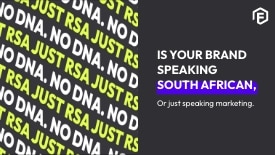Heritage as a Brand Story: How South African Businesses Can Build Authentic Connections
In South Africa, heritage is everywhere – from the rugged landscapes of the Drakensberg to the bustling townships of Johannesburg, and even at a Sunday braai. It is not merely a backdrop – it is part of the nation’s collective identity, a living and breathing resource that informs who we are. For South African brands, heritage is both a treasure chest and a tightrope: leveraged strategically, it can create authentic connections with audiences – misused, it can provoke ridicule or worse, social media outrage.
Brands that integrate heritage into their identity must navigate a complex landscape. South Africa is home to a multitude of ethnicities, languages, and cultural practices, which makes crafting messages that are inclusive, respectful, and engaging a challenge. Yet it also offers brands the opportunity to demonstrate sensitivity, creativity, and cultural pride – all qualities that resonate with modern consumers, particularly digitally savvy audiences.
Heritage and Brand Identity
Heritage is not just an accessory to your brand – it can be central to the story you tell. South African brands that succeed in this space often incorporate heritage in ways that feel authentic and relevant rather than decorative. Consider how brand identity can intersect with cultural storytelling: colours, symbols, language, rituals, and narratives can all become part of a brand’s DNA.
Brands that lean into heritage effectively don’t merely reference it superficially. It acknowledges the historical and cultural context, weaving it into products, messaging, and customer experiences. For instance, incorporating local motifs into packaging or collaborating with artisans from specific cultural communities not only honours the culture but also strengthens the perceived authenticity of the brand.
The Role of Heritage Sites
Heritage sites in South Africa serve as more than tourist destinations. They are tangible reminders of history, resilience, and cultural diversity. For brands, these sites are powerful reference points. They can inspire storytelling that resonates emotionally with audiences while providing context for campaigns.
Digitalisation amplifies this potential. Social media platforms allow audiences to engage virtually with heritage sites, participate in storytelling, and share their own experiences. Brands that leverage this can create campaigns that are interactive, visually compelling, and culturally meaningful. For example, a travel brand might create immersive social media content highlighting a heritage site, paired with narratives from local communities. This approach transforms marketing from a one-way broadcast into a shared cultural experience.
Cultural Diversity as a Brand Asset
South African brands operate in a context of profound cultural diversity. This diversity is not only a reality but also an asset. Brands that recognise and value multiple heritages in their campaigns demonstrate inclusivity and awareness.
Promoting cultural diversity involves more than visual representation. It requires an understanding of language nuances, regional customs and community values. Campaigns that are carefully researched and co-created with cultural practitioners tend to resonate more authentically. Digital platforms, particularly social media, amplify this engagement: interactive posts, participatory challenges, and – most importantly – user-generated content allow audiences to express their own connections to heritage while strengthening brand relevance.
Brands that succeed in this space strike a balance between celebrating unity and acknowledging difference. They respect local traditions, avoid flattening diversity into a single narrative, and use heritage as a bridge rather than a stereotype.
Digital Storytelling and Marketing
Digitalisation has transformed heritage engagement. South African consumers, especially millennials and Gen Z, are digitally fluent and culturally conscious. They expect brands to demonstrate both creativity and authenticity in online campaigns.
Platforms such as Instagram, TikTok, YouTube, and X are central to this. Instagram thrives on visual storytelling: brands can use photography, reels, or illustrated narratives to highlight heritage practices. TikTok encourages participatory content, enabling audiences to remix, duet, or share short cultural skits. YouTube allows for longer-form explorations, such as mini-documentaries or interviews with cultural advocates. X facilitates conversation, debate, and amplification of heritage campaigns through hashtags, threads, and live discussions.
Brands that integrate heritage into digital marketing successfully often do three things:
Invite participation: Whether through hashtag campaigns, challenges, or UGC, audiences want to contribute their own stories.
Be authentic: Collaboration with cultural influencers, community leaders, or artists ensures that campaigns are grounded in reality rather than superficial motifs.
Leverage storytelling: Every post, video, or interactive feature should reinforce the narrative that the brand values heritage, not just as decoration, but as part of its identity.
Social Media as a Cultural Amplifier
Social media is where heritage can move from being static to being lived. Brands that allow audiences to share, discuss, and reinterpret cultural narratives encourage engagement.
User-generated content (UGC): Encourages audiences to share personal heritage stories, recipes, or customs.
Interactive campaigns: Polls, quizzes, and AR filters enable audiences to explore heritage digitally.
Collaborations with influencers or local creators: Amplify campaigns while lending credibility.
Brands that understand the interplay between heritage, identity, and digital behaviour can create campaigns that resonate deeply and spread organically.
Lessons for Brands
For South African businesses seeking to integrate heritage into brand storytelling, several key principles emerge:
Authenticity is non-negotiable: Audiences can immediately detect superficiality.
Research and consultation are essential: Work with cultural experts, community representatives, or historians.
Balance specificity and universality: Highlight unique heritages while connecting to broader national identity.
Leverage digital tools wisely: Tailor content to each platform and encourage participation.
Celebrate diversity, don’t flatten it: Avoid one-size-fits-all narratives – rather, embrace complexity.
When done well, heritage-driven campaigns strengthen brand identity, create meaningful engagement, and demonstrate cultural sensitivity – all while telling a story that consumers remember.
Conclusion
Heritage is not just a backdrop for South African brands – it is a living, breathing asset that can inform identity, storytelling, and audience engagement. By leveraging heritage thoughtfully and digitally, brands can connect authentically with diverse audiences, celebrate cultural richness, and create campaigns that resonate across generations.
In South Africa, heritage is not merely something to be observed once a year during Heritage Month – it is an ongoing conversation, and brands that participate wisely in that conversation can build loyalty, inclusivity, and relevance, all without resorting to clichés or cringe.
P.S. Don’t forget to share this article.
Flume is an independent, full-service digital marketing agency providing services that include SEO, web design and development, public relations, media buying, client service, UX/UI, and creative production. For more information visit www.flume.co.za or email us at [email protected] to say, well, “hello”.
-
Frequently Asked Questions
-
1. Why are people using TikTok as a search engine instead of Google?
- TikTok has become a search engine for many, especially younger generations, because it delivers authentic, user-generated content through short-form videos. Unlike Google’s webpage indexing, TikTok offers answers rooted in lived experiences, complete with visuals and personal commentary, making it feel more relatable and trustworthy for queries like tutorials, reviews, or recommendations.
-
2. How is AI changing the way we search?
- AI-powered search tools like ChatGPT and Perplexity provide direct, synthesised answers instead of lists of links. They act like a concierge, understanding user intent and delivering contextualised responses, which shifts search from link-based discovery to instant answer delivery, challenging traditional SEO strategies.
-
3. Is Google still relevant with the rise of TikTok and AI search tools?
- Yes, Google remains a powerhouse for research-heavy and transactional queries, backed by decades of data and robust infrastructure. However, it’s adapting to competition from social platforms like TikTok and AI tools by introducing features like Search Generative Experience (SGE) to provide direct answers.
-
4. What does the shift to social and AI search mean for digital marketers?
Marketers must adopt multi-platform, multi-format strategies. This includes creating answer-focused content for AI, producing short-form videos for platforms like TikTok, leveraging user-generated content for trust, and optimizing for clear, natural language to align with AI discovery.
-
5. Can we trust AI search engines to provide accurate information?
- AI search engines are improving but can still produce inaccuracies or overconfident responses, sometimes referred to as “hallucinations.” While they’re powerful for quick, synthesised answers, users should verify critical information, especially for complex or sensitive queries.



